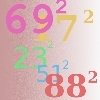Skip over navigation
The area of a rectangle is 225 square units.
Its length is 16 more than its width.
Find its width.
This problem is taken from the World Mathematics Championships



Or search by topic
Number and algebra
Geometry and measure
Probability and statistics
Working mathematically
Advanced mathematics
For younger learners
Length, Width and Area
Age 14 to 16
ShortChallenge Level 





- Problem
- Solutions
The area of a rectangle is 225 square units.
Its length is 16 more than its width.
Find its width.
This problem is taken from the World Mathematics Championships
You can find more short problems, arranged by curriculum topic, in our short problems collection.
You may also like
2-digit Square
A 2-Digit number is squared. When this 2-digit number is reversed and squared, the difference between the squares is also a square. What is the 2-digit number?
Consecutive Squares
The squares of any 8 consecutive numbers can be arranged into two sets of four numbers with the same sum. True of false?
Plus Minus
Can you explain the surprising results Jo found when she calculated the difference between square numbers?

